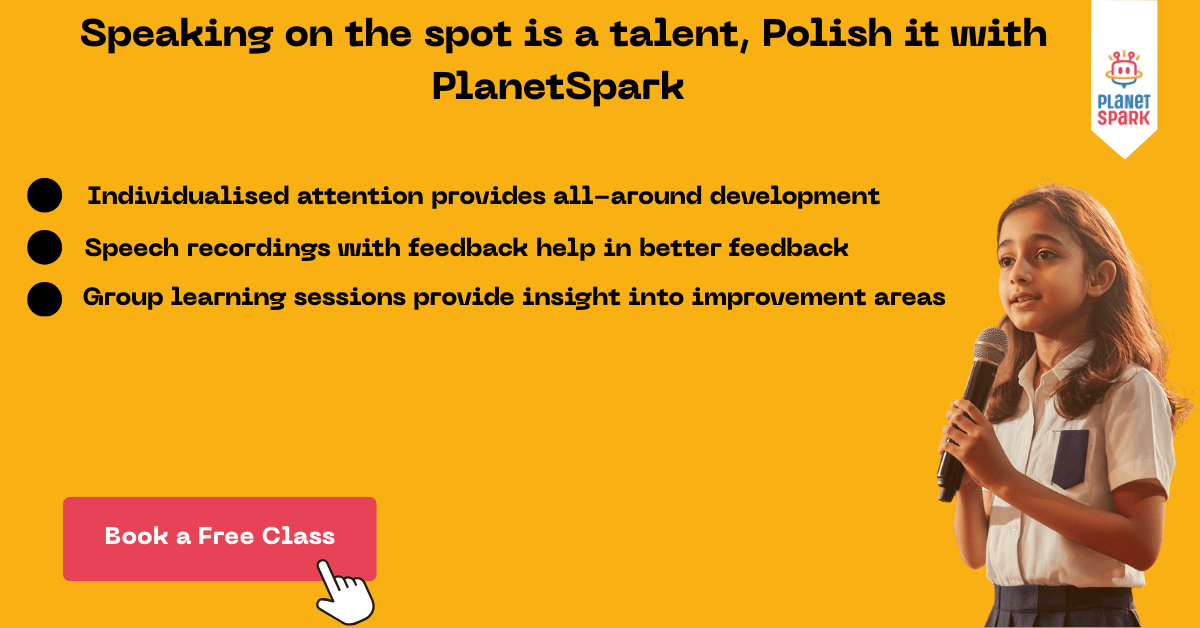Loud and Soft Sound: Meaning, Examples & Importance for Kids

Table of Contents
- What Is Sound?
- Loud Sound vs Soft Sound
- Why Do We Need Loud and Soft Sounds?
- Pitching in Voice Control: A Public Speaking Perspective
- Science Behind Loud and Soft Sound
- Activities for Kids to Understand Loud and Soft Sounds
- Loud and Soft Sound in Nature
- Why Choose PlanetSpark for Voice and Public Speaking Trainin
- Loud and Soft Sounds in Communication
- Helping Kids Balance Loud and Soft in Speech
- Conclusion
- FAQs on Loud and Soft Sound
Sound is everywhere. From the cheerful chirping of birds in the morning to the honking of cars on busy roads, our world is filled with different kinds of sounds. But have you ever wondered why some sounds are loud while others are soft? Understanding loud and soft sound is one of the simplest yet most exciting ways for children to explore the science of sound.
In this blog, we’ll dive deep into what loud and soft sounds are, how they are produced, their importance in daily life, and how children can learn to differentiate them. Along the way, we’ll also explore how public speaking builds confidence in kids by helping them control their voice knowing when to be loud and when to be soft.
What Is Sound?
Before we talk about loud and soft sound, let’s quickly understand what sound actually is.
Sound is a form of energy that travels in the form of waves. These waves are created when an object vibrates. For example:
When you pluck a guitar string, it vibrates and creates sound.
When you speak, your vocal cords vibrate and produce sound.
The strength or intensity of these vibrations decides whether the sound is loud or soft.
Help your child master the art of speaking with confidence. Enroll them in PlanetSpark’s Public Speaking Course today!
Book for a free trial class
Loud Sound vs Soft Sound
Loud Sound: A loud sound has strong vibrations. For example, a fire alarm, a drumbeat, or a lion’s roar. These sounds travel farther and catch our attention quickly.
Soft Sound: A soft sound has gentle vibrations. Examples include the ticking of a clock, whispering, or the rustling of leaves. Soft sounds usually create a calm and peaceful atmosphere.
Examples in Daily Life:
Loud: Thunder, a train passing by, clapping in an auditorium.
Soft: A mother humming a lullaby, the flutter of a butterfly’s wings, a distant flute.
Why Do We Need Loud and Soft Sounds?
Both loud and soft sounds have important roles in our lives:
Loud Sounds help in alerting us (e.g., alarms, sirens). They’re also useful in large gatherings when a speaker needs to address a crowd.
Soft Sounds bring peace and relaxation (e.g., listening to soft music before bed).
Learning to use loud and soft sounds appropriately is also crucial in public speaking. A speaker who knows when to raise their voice for emphasis and when to soften it for effect can capture an audience beautifully.
Pitching in Voice Control: A Public Speaking Perspective
Imagine your child giving a school presentation. If they speak in the same loud voice throughout, the audience will lose interest. Similarly, if they whisper everything, nobody will hear them. Knowing when to be loud and when to be soft makes all the difference.
This is exactly where PlanetSpark’s Public Speaking Course for Kids comes in.
Kids learn how to modulate their voice.
They practice real-life speaking situations.
They gain the confidence to speak in front of any audience.
Is your child struggling to adjust their voice while speaking?
Help them learn the art of voice modulation when to be loud and when to be soft through engaging activities and expert guidance.
Join your kid in our free demo class on Public Speaking Course for kids
Science Behind Loud and Soft Sound
The difference between loud and soft sounds lies in amplitude:
Amplitude is the height of the sound wave.
Higher amplitude = louder sound.
Lower amplitude = softer sound.
For example, hitting a drum with force creates a loud sound because the vibrations are stronger (higher amplitude). Tapping it gently creates a soft sound because the vibrations are weaker (lower amplitude).
Activities for Kids to Understand Loud and Soft Sounds
Here are some simple experiments and activities you can try with children:
Balloon Experiment
Take a balloon and blow air into it until it is firm. Now, gently tap the balloon with your fingers. You’ll hear a loud, echo-like thumping sound because the balloon is tightly filled and vibrates strongly. Next, release some air from the balloon and tap it again. This time, the sound will be much softer because the vibrations are weaker.
This experiment helps children clearly understand how the amount of vibration (amplitude) affects the loudness of a sound.
Clap Game
Ask children to clap their hands loudly once it creates a sharp, strong sound that can easily grab attention. Now, ask them to clap softly once it produces a lighter, gentler sound. Repeat the activity in a rhythm: loud clap, soft clap, loud clap, soft clap.
This game improves listening skills, sound awareness, and rhythm. It also makes children conscious of how they can control the force of their actions to produce different sound levels.
Storytelling with Voices
Pick a short story and assign roles to kids. For example:
The villain should use a loud, commanding voice to sound scary.
The fairy or kind character should use a soft, soothing voice to sound gentle.
Other characters can have voices in between, depending on their role.
As kids narrate the story with different voice levels, they not only learn about loud and soft sounds but also practice expression, creativity, and confidence in speaking. This is a fantastic way to connect science with communication and public speaking skills.
Loud and Soft Sound in Nature
Nature is full of examples of sound variations:
A lion’s roar is loud and powerful.
The chirping of crickets is soft and soothing.
Waves crashing on rocks are loud, while water dripping is soft.
Teaching kids to notice these differences enhances their listening skills and appreciation for the environment.
Why Choose PlanetSpark for Voice and Public Speaking Training?
Here’s why parents around the world trust PlanetSpark:
Personalized Coaching: Each child gets individual attention.
Voice Modulation Training: Kids learn when to use loud tones and when to soften their voice.
Confidence Building: From class speeches to competitions, children become stage-ready.
Fun Learning: Activities, games, and storytelling keep children engaged.
Choose PlanetSpark today and watch your child become a confident speaker tomorrow!

Loud and Soft Sounds in Communication
Communication is not just about the words we speak but also how we deliver them. Loud and soft sounds can:
Express emotions (anger may be loud, kindness is soft).
Create emphasis (raising your voice at key points).
Show politeness (lowering your voice in respectful situations).
Kids who master this early find it easier to express themselves in debates, storytelling competitions, or everyday conversations.
Helping Kids Balance Loud and Soft in Speech
Children often struggle with speaking either too softly (shy kids) or too loudly (overexcited kids). Here are some tips:
Practice Reading Aloud
Encourage children to pick a short story or a poem and read it aloud. Ask them to change their voice levels according to the situation:
When the character is excited, they should read in a louder voice.
When the character is scared or whispering, they should read in a softer tone.
2. Record and Playback
Give your child a mobile phone or recorder and ask them to say a sentence loudly (e.g., “I love chocolate ice cream!”) and then say the same sentence softly. Play the recording back and listen together. Discuss how the two versions sound different and where each might be useful—for example, loud in a school presentation, soft when telling a secret.
3. Games like Simon Says
Modify the classic Simon Says game by adding voice-level commands. For example:
“Simon says, say your name loudly.”
“Simon says, say hello softly.”
“Simon says, roar like a lion loudly.”
“Simon says, buzz like a bee softly.”
Children love following these playful instructions, and it turns learning into a game.
PlanetSpark’s trainers guide kids through such fun exercises, ensuring they learn voice control while enjoying themselves.
Try yourself by taking our free demo class!
Conclusion
Loud and soft sounds are not just about noise levels they are about communication, emotions, and confidence. From nature to music, from science to storytelling, the world around us is shaped by the balance of loud and soft.
When children understand and practice these differences, they not only become better listeners but also powerful speakers. With guidance, they can learn to raise their voice when needed and lower it when appropriate.
FAQs on Loud and Soft Sound
Q1. What is the difference between loud and soft sound?
A. A loud sound is produced by strong vibrations with high amplitude, while a soft sound is produced by weak vibrations with low amplitude.
Q2. Can you give examples of loud and soft sounds?
A. Yes. Examples of loud sounds include thunder, a fire alarm, or a drumbeat. Examples of soft sounds include whispering, a ticking clock, or rustling leaves.
Q3. Why are loud and soft sounds important?
A. Loud sounds help in catching attention or warning people, while soft sounds create calmness and relaxation. Both play a role in communication and daily life.
Q4. How can children learn to identify loud and soft sounds?
A. Children can practice clapping loudly and softly, listen to sounds in nature, or engage in activities like storytelling with different voice levels.
Q6. Are loud sounds always harmful?
A. Not always. Loud sounds can be useful, such as alarms or announcements. However, prolonged exposure to very loud sounds can damage hearing.
Personalized Communication Report
Record a video to get a AI generated personalized communication report for your child

Hi There, want to try these
tips for your child with
LIVE with our expert coach?
Let's check your child's
English fluency
